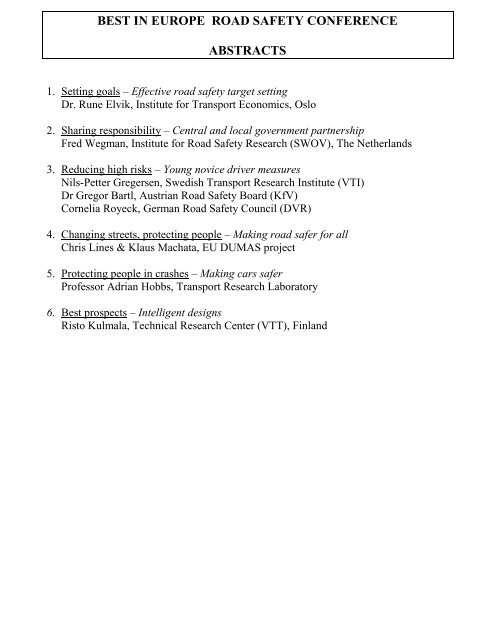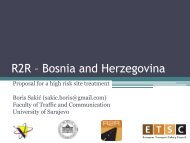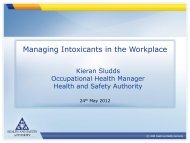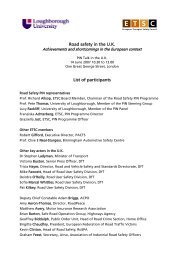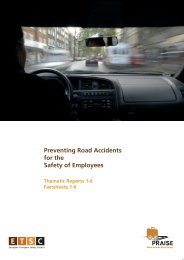BEST IN EUROPE ROAD SAFETY CONFERENCE - ETSC
BEST IN EUROPE ROAD SAFETY CONFERENCE - ETSC
BEST IN EUROPE ROAD SAFETY CONFERENCE - ETSC
Create successful ePaper yourself
Turn your PDF publications into a flip-book with our unique Google optimized e-Paper software.
<strong>BEST</strong> <strong>IN</strong> <strong>EUROPE</strong> <strong>ROAD</strong> <strong>SAFETY</strong> <strong>CONFERENCE</strong><br />
ABSTRACTS<br />
1. Setting goals – Effective road safety target setting<br />
Dr. Rune Elvik, Institute for Transport Economics, Oslo<br />
2. Sharing responsibility – Central and local government partnership<br />
Fred Wegman, Institute for Road Safety Research (SWOV), The Netherlands<br />
3. Reducing high risks – Young novice driver measures<br />
Nils-Petter Gregersen, Swedish Transport Research Institute (VTI)<br />
Dr Gregor Bartl, Austrian Road Safety Board (KfV)<br />
Cornelia Royeck, German Road Safety Council (DVR)<br />
4. Changing streets, protecting people – Making road safer for all<br />
Chris Lines & Klaus Machata, EU DUMAS project<br />
5. Protecting people in crashes – Making cars safer<br />
Professor Adrian Hobbs, Transport Research Laboratory<br />
6. Best prospects – Intelligent designs<br />
Risto Kulmala, Technical Research Center (VTT), Finland
1. Setting goals– Effective road safety target setting<br />
Dr. Rune Elvik, Institute for Transport Economics, Oslo<br />
This paper reports a study of the effectiveness of quantified road safety targets set by local or national<br />
governments. A total of 28 quantified road safety targets have been assessed, of which 12 set by local<br />
governments and 16 set by national governments. A statistically significant difference in safety<br />
performance associated with quantified road safety targets is found, when countries or local<br />
governments that have set targets are compared to countries or local governments that have not set<br />
quantified targets. The largest difference in safety performance is associated with long-term, ambitious<br />
targets set by national governments. On the average, countries or local governments that have set<br />
quantified road safety targets have experienced a 0.8% greater annual reduction of the number of road<br />
accident fatalities after targets were set than countries or local governments that did not set such<br />
targets. It is impossible to establish a causal relationship between quantified road safety targets and<br />
safety performance. The possible effects of three confounding factors to the results of the study were<br />
assessed. The confounding factors assessed included regression-to-the-mean, differential turns of the<br />
business cycle, and selective recruitment. Selective recruitment means that quantified targets tend to be<br />
adopted in countries that are particularly concerned about road safety, and might therefore have<br />
performed better than other countries in any case. Although these confounding factors may have<br />
influenced study results to a certain extent, it is unlikely that the entire difference in safety<br />
performance associated with quantified road safety target can be attributed to the confounding factors.<br />
Key words: Road safety target, quantified target, evaluation, before-and-after study
2. Sharing responsibility – Central and local government partnership<br />
Fred Wegman, Institute for Road Safety Research (SWOV), The Netherlands<br />
Road safety should be seen as an important, negative result of mass-motorisation. This, even in spite of<br />
the fact that the present day traffic is a lot safer than it was. The growth in mobility does not seem to be<br />
accompanied by an equal growth in road safety. Road accidents are not an inescapable phenomenon;<br />
they can be (positively) influenced. The approach to road safety has not always been the same. Periods<br />
can be distinguished, each with different paradigms. For example, accidents as a chance phenomenon,<br />
accidents are caused by the accident-prone, accidents are mono-causal, and humans are the weak link.<br />
There are two paradigms dominant in road safety science at the beginning of the 21st century. The first<br />
to implement the theoretically effective measures better and on a greater scale; and to more effectively<br />
use the financial resources. This is the basic idea of the recent EU communication about road safety.<br />
The second paradigm involves the idea that the present road traffic system is inherently or intrinsically<br />
unsafe, and that a considerable greater road safety can only be achieved by regarding safety as an<br />
important design criterion of the road transport system. This idea has been developed further, and is<br />
now part of the safety policy in the Netherlands. The name that has been given to this approach is:<br />
sustainably safe road traffic.<br />
In sustainably safe road traffic “man is the measure of all things”. This means not just taking action if<br />
accidents occur, but creating those road traffic conditions that drastically reduce the chance of<br />
accidents in advance; this by infrastructure design. If accidents still happen, the process which<br />
determines the severity of these accidents should be influenced so that serious injury is virtually<br />
excluded.<br />
This radical vision can only be achieved in practice if there is sufficient social and political support.<br />
Support is, on the one hand, determined by how serious society really takes road safety. On the other<br />
hand, how much is society prepared to pay (in whatever form) for ‘more safety’. An important way to<br />
measure political support in the Netherlands is the so-called quantitative road safety target. Such a<br />
target for 2000 exists since 1985. It is to be expected that Government and Parliament will soon set a<br />
new target for 2010. The views of the road safety actors are important for a) acquiring social support<br />
and b) for creating favourable possibilities for actually implementing the policy.<br />
What follows is how to achieve this target. In the Netherlands, it is not just the idea of taking effective<br />
and socially profitable (cost-effective) measures; measures and policy should also fit in the sustainably<br />
safe vision. A great deal of effort has been spent on getting the vision accepted by road safety<br />
professionals; and after this to stimulate all (which means 100%) the actors (municipalities, provinces,<br />
police forces and traffic and safety organisations) to actual implementation. In this, the national<br />
government plays a goading role; not one of determining everything. Central and local governments<br />
are partners, each with their own responsibilities.<br />
In 1997 a covenant was signed between the Minister of Transport, the provinces, the municipalities,<br />
and the water boards. This was the so-called Start-up Programme on Sustainable Safety. In this<br />
covenant, the partners obliged themselves to carry out a concrete programme of measures. In this, there<br />
are the following components: new rules and regulations, infrastructural measures, enforcement,<br />
education and information, transfer of knowledge, and making the plans for the second phase. The<br />
covenant is for a period of 5 years. Demonstration projects are carried out and carefully monitored.<br />
One example of the Start-up programme is the agreement concerning 30 km/h streets. Of the 48000 km<br />
of streets which have been designated as potential 30km/h-streets in the Netherlands, the Start Up<br />
programme agreed to design and construct 35% of these with low-cost measures in a period of 5 years<br />
to the year 2002.<br />
In the meantime, plans for the next phase of sustainable safety are being made. These will form a part<br />
of the National Traffic and Transport Plan, which will be published in 2000.
3. Reducing high risks – Young novice driver measures<br />
Nils-Petter Gregersen, Swedish Transport Research Institute (VTI)<br />
The overrepresentation of young drivers in accidents is a<br />
problem that is present in most countries. The diagram<br />
below shows the situation in a sample of countries<br />
regarding number of killed persons in car accidents per<br />
100 000 of population in different age groups.<br />
200<br />
180<br />
160<br />
140<br />
120<br />
100<br />
80<br />
60<br />
40<br />
20<br />
0<br />
Luxembourg<br />
Belgium<br />
Killed in car accidents per 100 000 of population<br />
18-24<br />
25-64<br />
65+<br />
Austria<br />
Lithuania<br />
Estonia<br />
Latvia<br />
USA<br />
Iceland<br />
Portugal<br />
Norway<br />
Czech Rep.<br />
Spain<br />
Switzerland<br />
Italy<br />
Poland<br />
Finland<br />
Netherlands<br />
UK<br />
Sweden<br />
Much research has been done to explain the reasons why<br />
young drivers are at high risk and the knowledge base<br />
has grown rapidly. Today there is a high level of such<br />
knowledge, which is available for application into driver<br />
training programs. One such aspect is the importance and<br />
nature of experience. Most of the accident reduction<br />
during the first years with a licence is explained by<br />
increased experience behind the wheel. In Sweden, this<br />
knowledge has been used as a base for lowering the age<br />
limit for practising from 17½ to 16 years. In 1993 it<br />
became possible to practice with a professional or a lay<br />
instructor during two years before driving alone behind<br />
the wheel. This was a way to avoid the paradox that<br />
experience normally is gained during the most dangerous<br />
first period of being a driver, that is, after obtaining a<br />
licence.<br />
A comprehensive evaluation of the lowered age limit<br />
was carried out at VTI and the results showed high level<br />
of utilisation, 2.5-3 times increase of amount of practising<br />
and a dramatic reduction of accident risk. The<br />
accident risk of those who made use of the new possibi-<br />
Accidents per 1000 licence holders<br />
1.4<br />
1.2<br />
1<br />
0.8<br />
0.6<br />
0.4<br />
0.2<br />
0<br />
Accident development the first 24 months with a<br />
licence<br />
Utilizers<br />
Control<br />
1 2 3 4 5 6 7 8 9 10 11 12 13 14 15 16 17 18 19 20 21 22 23 24<br />
Months with a licence<br />
lities was almost 40% lower than the situation before the<br />
change. The total reduction of accident risk among all<br />
18-19 years old drivers was 15%. The accident development<br />
among utilises and a control group over the first<br />
two years with a licence is shown in the figure above.<br />
Even if the safety effects of the reform was dramatic,<br />
there is, however, still a large over-risk among the young<br />
drivers in Sweden. The national reduction was 15% that<br />
indicates that there is still much to be done to reduce<br />
their accident involvement. The list below summarises<br />
current state of the art regarding what competencies that<br />
are necessary to become a safe driver.<br />
A safe driver is not only skilled,<br />
but also sensible and wise:<br />
• Knows how to control the car<br />
• Knows and understands the rules<br />
• Knows how to drive in traffic<br />
• Has much experience<br />
• Has calibrated own skill<br />
• Is aware of risks<br />
• Does not drive with dangerous motives<br />
• Is planning trips safely<br />
• Is aware of possible outcome of peerpressure<br />
• Is aware of possible influence of social<br />
and personal preconditions<br />
• Is reflecting on the consequences of<br />
own behaviour<br />
Many of these competences have not traditionally been<br />
covered in driver training even if we know they are<br />
important. The focus has been on the three first aspects<br />
of the list. The awareness of the complexity of young<br />
driver safety has encouraged the Swedish Government<br />
and the Swedish National Road Administration (SNRA)<br />
to develop a new staged driver education and a new<br />
educational content/ national curriculum. The strategy in<br />
the new system, which is currently examined by the<br />
Government, has been to implement frontline knowledge<br />
about driver behaviour and young drivers and to make<br />
use of the advantages of the 16 years age limit. The<br />
structure of the suggested system is shown in the figure<br />
below. A more comprehensive description is available at<br />
the SNRA (www.vv.se).<br />
Initial ed. Stage 1 Stage 2 Stage 3 Follow up<br />
Learner: Prof+Lay Prof+Lay Prof+Lay 2 years<br />
Ed. syst. Simple Advanced All Driver<br />
Rules environm. environm. environm. improve-<br />
Risks No pass. No pass. Pass. ok. ment<br />
Obligatory Obligatory Obligatory<br />
Written test highway risk+skid 1st aid<br />
L permit Diagnosis Diagnosis Written test<br />
Lay instr:<br />
Unsupervised<br />
Ed. syst. Individual<br />
practice (restr.)<br />
Responsib. ed. plan<br />
Risks<br />
L-plate + mirror<br />
Driving test<br />
Instr permit Full licence
3. Reducing high risks – Young novice driver measures<br />
Dr Gregor Bartl, Austrian Road Safety Board (KfV)<br />
As early as 1 January 1992 the driving license on probation for all novice drivers, regardless of age,<br />
was introduced in Austria. The law prescribes a probation period of two years. During this period<br />
holders of a driving license on probation have to observe a .01%-limit of blood alcohol concentration.<br />
Offences against the .01%-limit as well as serious traffic offences (extremely exceeding the speed<br />
limit, causing an injury or fatality etc.) lead to an obligatory participation in a psychological driver<br />
improvement course and to an extension of the two years probation period for an additional year.<br />
Five years after the introduction of the driving licence on probation an analysis was carried out<br />
concerning the number of passenger car drivers involved in accidents with personal injuries and<br />
fatalities. In this analysis holders of a driving licence on probation were compared with all the other<br />
drivers. The results indicate a continuous decrease of accident involvement of 32.5% within the group<br />
of novice drivers. Whereas the decrease within the group of all the other drivers was merely 8.9% in<br />
the period of time observed.<br />
In the year of the introduction of this law (1992) 19.2% new licences less were issued compared to the<br />
year before. Even when taking into account this declining number of novice drivers the analysis still<br />
indicates an accident reduction of 18.7% (number of novice drivers involved in accidents with personal<br />
injuries and fatalities related to the declining number of holders of driving licences on probation).<br />
Drunk driving accidents of novices decreased in this period of time even more significantly.<br />
Evaluation studies of the psychological driver improvement courses for drunk drivers proved an almost<br />
50% lower rate of repeated drunk driving offences of drivers who participated in such a course<br />
compared to a control group without course participation.<br />
In addition to this driving license on probation system with individual rehabilitation for violators only,<br />
now in Austria the implementation of a general preventive approach for all novice drivers is under<br />
discussion. A proposal of a multiphase driver training is going to be elaborated by a national expert<br />
group. The substantial elements are: On the one hand before the acquisition of the driving license,<br />
more safety orientated contents in the basic driver education and harmonisation with the driver test, on<br />
the other hand after the acquisition of the license, two times one hour feedback in real traffic with a<br />
driving teacher and a specific one day safe driving course on a test track – designed to avoid self overestimation<br />
of participants’ driving skills – in combination with a ninety minutes psychological course.<br />
This concept has partly been applied during the last year on a voluntary basis. This campaign “Road<br />
Expert”, offered and financially supported by the Minister of traffic, included such a safe driving<br />
course with a psychological discussion. About 5,000 novice drivers participated and their feedback<br />
was highly positive. Almost all participants recommended that all novice drivers should participate in<br />
such a course.
3. Reducing high risks – Young novice driver measures<br />
Cornelia Royeck, German Road Safety Council (DVR)<br />
For fifteen years now, the German Road Safety Council (DVR) has been running prevention<br />
campaigns against “alcohol in road traffic and at the workplace” with the support of the Association of<br />
Insurances for Occupational Safety, the Federal Ministry of Transport, Housing and Building and<br />
several member organizations of DVR.<br />
In 1999, 28,350 accidents resulting from alcohol impairment occurred in Germany, thereby 24,886<br />
persons were slightly injured, 12,110 were severely injured, and 1,114 persons were killed. Of those<br />
involved in road accidents who tested positive for alcohol, 52% were young road users between the<br />
age of 18 and 34 years. The campaign “Darauf fahr’ ich ab... Nur nüchtern am Steuer – I really go for<br />
that ... Be sober at the wheel” focuses on this target group and their leisure and work environments.<br />
The aim of this road safety campaign, which started in three pilot regions (county and city of<br />
Schleswig-Flensburg, greater Saarbrücken, and the county Niederschlesischer Oberlausitzkreis) in<br />
1996, was to persuade both young drivers and young passengers that they should strictly separate<br />
drinking from driving. Elements of the campaign were information materials such as leaflets, posters<br />
and brochures as well as a direct communication with the target group using personal letters to young<br />
women between 16 and 24, and young males between 18 and 24 signed by the lord-mayor which<br />
informed them about the risk to be involved in an accident in their usual surroundings. Within the<br />
letters for the women, telephone cards were included to provide them a possibility to call somebody to<br />
pick them up instead of being driven by a drunken driver. The campaign was complemented by<br />
additional police enforcement and alcohol tests.<br />
Three research approaches were combined to evaluate this road safety campaign: a qualitative survey,<br />
a quantitative survey and the evaluation of data sources of third parties. In order to ascertain the<br />
effectiveness of the campaign, over 10,000 persons from the target group received and answered a<br />
questionnaire related to the attitudes relevant to the leisure time accidents and to their changes of<br />
behaviour in connection with the campaign. Discussions with representants of the target group as well<br />
as the result of the surveys show that the attitudes and modes of behaviour contain gender-specific<br />
components, although the behaviour of young men and women does overlap. The evaluation of the<br />
results of alcohol checks by the police shows a clear reduction in the number of intoxicated drivers and<br />
alcohol-associated accidents in the pilot regions, where the number of accidents resulting from alcohol<br />
impairment decreased by 27.5%.<br />
The evaluation was very positive so that this campaign was continued in 1998 in 17 regions of 12<br />
Laender, and in 1999 in 14 regions of 11 Laender, and this year in 6 regions of 3 Laender, having<br />
similar positive results.
4. Changing streets, protecting people – Making road safer for all<br />
Chris Lines & Klaus Machata, EU DUMAS project<br />
DUMAS is a 1.2M ECU project with 10 Partners from 9 countries. The project<br />
brought together European experience and expertise on Urban Safety Management (USM),<br />
including practical examples from 10 towns. It promotes an area-wide strategic approach and<br />
the integration of other urban initiatives into safety strategies and programmes.<br />
Every year over 43,000 people die in the EU countries; more than half of these in urban<br />
areas. Of these urban accidents, just over half occur at ‘black sites’, but the rest are ‘scattered’ throughout the<br />
area and are more difficult to treat. USM is the method for treating these. As more ‘black site’ treatments are<br />
done, the proportion of scattered accidents will increase, which will make the USM approach more important in<br />
the future.<br />
The Research Phase produced a summary of the current knowledge on USM, plus a comprehensive analysis of<br />
four specific topics - Speed, Accident Data, Vulnerable Road Users and Traffic Management. DUMAS<br />
concluded that the measures are understood, but asks the question why are they not implemented on a larger<br />
scale ?<br />
traffic<br />
control<br />
network<br />
management<br />
Police<br />
enforcement<br />
Education<br />
Central<br />
Government<br />
F<strong>IN</strong>ANCE<br />
Road users<br />
DUMAS VISION OF USM<br />
LOCAL<br />
POLITICS<br />
TOWN HALL<br />
traffic environment<br />
safety planning Land<br />
use<br />
URBAN <strong>SAFETY</strong> PROGRAMME<br />
Analysis<br />
Strategy<br />
Planning<br />
Design<br />
Implementation<br />
Assessment<br />
Country<br />
Public Opinion<br />
Local<br />
Public Opinion<br />
Health<br />
Public<br />
Transport<br />
Design and assessment frameworks have been produced that give<br />
guidance to town planners and managers. These provide a checklist of<br />
issues which need to be addressed as part of the programme, with guidance<br />
as to how the processes need to be managed.<br />
Town studies are an essential part of the DUMAS project. This phase<br />
investigated 10 study towns where safety activities have taken place and<br />
looked at the application of DUMAS concepts identified in the research<br />
phase. The political, legal, and social pressures were also studied.<br />
The Baden Town Study demonstrates a<br />
number of the USM factors that, according to DUMAS, form the foundations of a<br />
successful design. These include an implementation and assessment process and an<br />
integrated traffic and safety plan. The presence of decision-makers with a view for<br />
broad perspectives and a forum to provide consultation with the public were also<br />
major factors, as was good co-operation between the “town hall” and key<br />
institutions at municipal level, such as the police and the public transport operators.<br />
The formulation of an overall urban safety management strategy and the application<br />
of a wide range of measures, have reduced accidents by 60% between 1986 and<br />
1999. Baden is now one of the safest cities in Austria. The measures include those specifically for safety<br />
improvements, but also include flow and speed management, improvement in public transport and increases in<br />
cycling. The DUMAS vision of Urban Safety Management has been shown to work in Baden.<br />
Road accidents are predicted to be the 3 rd largest cause of death in the world by 2020 and much more needs to<br />
be done to reduce the carnage in EU countries. Reliable proven methods are available for reducing accidents –<br />
we just need to have more of them. The DUMAS project has shown that urban scattered accidents can be<br />
reduced significantly by the application of the methods proposed.<br />
The DUMAS partners have a vision of Europe where safety is a high priority, accident rates are<br />
falling, mobility is increasing and Urban Safety Management is common in towns and cities. If<br />
the DUMAS project can help bring this about, it will have succeeded.<br />
Contact Mr Chris Lines, TRL, Crowthorne, Berks, UK (CLines@trl.co.uk) tel +44 (0) 1344 770246<br />
And Mr. Klaus Machata, KfV, Box 190, A-1031 Vienna, Austria (klaus.machata@kfv.at) tel +43 171770 214
5. Protecting people in crashes – Making cars safer<br />
Professor Adrian Hobbs, Transport Research Laboratory, UK<br />
Improving vehicle safety is the most effective means of reducing road accident deaths and injuries. It is<br />
highly cost effective, has good public acceptance and is suited to widespread uniformly application.<br />
Consumer crash test information from EuroNCAP is bringing about rapid improvements by providing<br />
an incentive to manufacturers to make improvements. Legislation provides a minimum standard (but a<br />
high level of protection to fulfill Treaty obligations) which all cars must achieve. The European Union<br />
has recently introduced frontal and side impact requirements which manufacturers are significantly<br />
exceeding, as a consequence of EuroNCAP. Unfortunately, there is no evidence from EuroNCAP tests<br />
of improvements in pedestrian protection. The industry still needs to be convinced of the marketing<br />
benefits from providing pedestrian protection. This means that legislation is desperately needed. All<br />
the necessary research is complete, only prevarication continues.<br />
For the future, EuroNCAP will develop in order to continue to provide the opportunity to recognise<br />
better car safety, to obviate the opportunities for misleading the public and to overcome the inevitable<br />
deficiencies which start to arise with the tests and the dummies. EuroNCAP is also concerned to take<br />
advantage of the growing knowledge of new priority issues such as compatibility.
6. Best prospects – Intelligent designs<br />
Risto Kulmala, Technical Research Centre (VTT), Finland<br />
The emergence of the information society has also meant that new tools are being made available for<br />
road safety work. These new tools are especially linked to transport telematics or Intelligent Transport<br />
Systems (ITS). There are many ways in which ITS affect safety. A review performed by a working<br />
group of <strong>ETSC</strong> (1999) classified the systems and their impact on safety according to the three main<br />
dimensions contributing to the number of fatalities in road traffic: exposure in traffic, risk of a crash<br />
given the exposure, and risk of fatalities in a crash. ITS have the potential to improve safety along each<br />
one of the three mentioned dimensions:<br />
There are a wide range of ITS applications addressing traffic volume and thus exposure. Practical<br />
experience as well as research results show that it is possible to reduce exposure by means of these<br />
applications. Many of these applications will be introduced as a matter of course as safety objectives<br />
go hand in hand with other traffic policy goals such as energy consumption and environment. A<br />
number of applications include benefits for drivers in terms of improved information and other<br />
services. That will facilitate the introduction of systems such as road pricing schemes, travel planners,<br />
route guidance and freight and fleet management. One of the ITS applications described has an<br />
outstanding potential in terms of accident savings. That is the electronic driver’s licence, which<br />
directly addresses the driver’s authorisation and ability to drive the vehicle.<br />
A number of systems exist with high safety potential in reducing crash risk. On motorways, the most<br />
safety beneficial systems have the potential for reducing injuries and fatalities by about 10–15 per cent.<br />
These systems are motorway control systems, driver and vehicle monitoring systems, intelligent speed<br />
adaptation, collision avoidance systems, incident management and automated speed enforcement.<br />
On other rural roads, current systems with the potential of reducing injuries and fatalities by more than<br />
10 per cent are fewer than on motorways, but more effective. Intelligent speed adaptation has a 30 per<br />
cent and automated speed enforcement a 20 per cent injury reduction potential. The ITS systems with<br />
the highest safety potential are intelligent speed adaptation, automated speed enforcement, speed<br />
control systems with variable speed limits, and driver and vehicle monitoring systems<br />
In urban areas, systems with most safety potential (injury reduction of 30 per cent for full<br />
implementation) are intelligent speed adaptation and urban traffic control.<br />
ITS offer sensing and communicating systems that may improve the effectiveness of protective devices<br />
such as seat belts and air bags substantially, thereby contributing to the reduction of crash<br />
consequences. At the present level of development the largest safety potential exists in increasing seat<br />
belt wearing rate by means of belt interlock warning systems and by means of emergency notification<br />
(Mayday) systems.<br />
In the short and medium term, by far the most promising prospect of improving road safety with the<br />
help of ITS is to implement intelligent speed adaptation (ISA, sometimes also called External Vehicle<br />
Speed Control EVSC). ISA systems not only have the potential of reducing crash risks considerably<br />
but they also will reduce the consequences of the crashes.<br />
Different systems for ISA exist and are planned, ranging from informative to intervening systems.<br />
Speed recommendations can be given via in-vehicle systems signalling with light and sound if the<br />
driver exceeds the speed limit. Such systems are expected to reduce the number of injury accidents by<br />
ca. 10% and fatalities by ca. 18%. A voluntary system, where the driver can enable or disable control<br />
by the vehicle of the maximum speed has been estimated to affect safety in a similar fashion (Carsten<br />
& Fowkes 2000). The compulsory or intervening system has been estimated to reduce injury accidents<br />
by ca. 20% and fatalities by almost 40% (Carsten & Fowkes 1998, Gustafsson 1997, Lind 1997).
Várhelyi (1997) has estimated that automatic speed limiting on rural roads would reduce the total<br />
number of injury accidents in Sweden by about 10%.<br />
ISA can also be implemented as a dynamic version, where in addition to fixed speed limits the system<br />
applies temporary limitations to maximum speed due to congestion, fog, slippery road surfaces, major<br />
incidents, outside schools at drop-off or pick-up times, etc. Dynamic ISA in conditions of low friction<br />
would decrease the total number of injury accidents by ca. 12% and ISA in darkness by 12% (Várhelyi<br />
1997). Carstern and Fowkes (2000) estimate that the dynamic version of the compulsory ISA reduces<br />
injury accidents by 36% and fatal accidents by 59%.<br />
References<br />
Carsten, O. & Fowkes, M. 1998. External Vehicle Speed Control, Phase I results: Executive summary.<br />
University of Leeds and the Motor Industry Research Asociation.<br />
<strong>ETSC</strong> 1999. Intelligent transportation systems and road safety. European Traffic Safety Council<br />
Working Group, May 1999.<br />
Gustafsson, P. 1997. ISA Intelligent Speed Adaptation. Who Wants It? . Proceedings, 4th World<br />
Congress on Intelligent Transport Systems, 21-24 October, Berlin, Germany. ITS America, ERTICO<br />
& VERTIS.<br />
Lind, G. 1997. Strategic assessment of intelligent transport systems - a user-oriented review of models<br />
and methods. Royal Institute of Technology, Department of Infrastructure and Planning, TRITA-IP FR<br />
97-29.<br />
Várhelyi, A. 1997. Dynamic speed adaptation in adverse conditions. Proceedings, 4th World Congress<br />
on Intelligent Transport Systems, 21-24 October, Berlin, Germany. ITS America, ERTICO &<br />
VERTIS.


